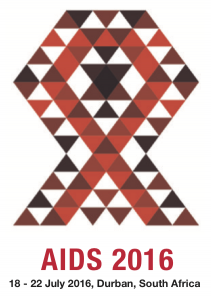High death rates among HIV positive women postpartum accessing ARVs
1 October 2016. Related: Conference reports, Antiretrovirals, Pregnancy, World AIDS 21 Durban 2016.
Despite high uptake of ART in pregnancy and postpartum, HIV positive women were five times more likely than negative women to die within two years of delivery, regardless of their CD4 count – according to data from Botswana presented at AIDS 2016.
Rebecca Zash – on behalf of colleagues from the Harvard group in Botswana – showed findings from a study to determine 24-month mortality rate in positive and negative postpartum women and evaluate risk factors for HIV positive women in a setting with widespread use and ART and PMTCT.
The study recruited HIV positive and HIV negative mothers 18 years and older within 48 hours of delivery at five public hospital maternity. Women who were unable to provide a telephone contact for herself a family member or friend were excluded (Dr Zash noted that few participants were excluded for this criterion as mobile phones are widely used in Botswana).
Antiretrovirals were provided by the government (free for citizens) according to national guidelines. Recommendations and provision changed over the study period: before June 2012 WHO Option A (AZT/3TC/NVP for pregnant women with CD4 <250 cells/mm3 and AZT monotherapy for women with CD4 >250 cells/mm3; from June 2012 WHO Option B with TDF/FTC/EFV for pregnant women (adult ART cut-off moved to 350 cells/mm3).
Women were contacted by mobile phone at 1 and 3 months, then every 3 months until 24-months post-partum. Home visits were conducted if a participant could not be reached and the investigators attempted to confirm whether a woman was dead or alive with a family member if she was still unreachable.
From February 2012 to March 2013, 1499 HIV positive and 1501 HIV negative women were enrolled. Of these, 2979 (96%) had complete follow up data available: 106 (3.5%) were not followed after death of their child; 9 (0.3%) withdrew from the study; and 6 (0.2%) were lost to follow up.
HIV positive mothers were: older (median 29 vs 24 years); less likely to be reporting their first pregnancy (16% vs 45%)and had a lower socioeconomic status (by education, sanitary, electricity and drinking water at home indicators), compared with negative mothers. Approximately 90% of all women had a vaginal delivery.
Before conception, 34% received ART; during pregnancy 92% received antiretrovirals (71% ART and 29% AZT) and by 24 months follow up 79% received ART.
There were 26 total maternal deaths overall in 24-months post-partum (439 per 100,000 person-years), 22 among HIV positive women (758 per 100,000 person-years) and 4 among HIV-uninfected women (138 per 100,000 person-years). HIV positive women were five times more likely than HIV negative women to die: aHR 5.0 (95% CI 1.6-15.2).
There were 13 (59%) deaths among women who received ART in pregnancy and throughout follow up (ref); 2 (9%) in women who stopped ART or AZT postpartum but started ART in follow up, ahR 0.9 (95% CI 0.3-6.4); 4 (18%) in women who received ART or AZT in pregnancy but stopped postpartum, aHR 1.7 (95% CI 0.6-5.1); and 3 (14%) in women receiving no antiretrovirals during pregnancy, aHR 1.6 (95% CI 0.2-15.2).
In multivariate analysis maternal age, availability of indoor toilet, formal housing, Rh factor, preterm delivery and higher parity were not associated with mortality. Longer ART duration before delivery (>2 years) did not decrease mortality.
CD4 cell count in pregnancy was unrelated to mortality (median 421 cells/mm) p=0.20.
Comment
This depressing study demands further investigation into the causes of death among HIV positive women postpartum despite access to ART. This phenomenon is probably more widespread than has been documented to date. Identifying the extent and causes of mortality in order to put mechanisms in place to help to address this is a matter of urgency.
Reference:
Zash et al. High proportion of deaths attributable to HIV among post-partum women in Botswana despite widespread uptake of ART. 21st International AIDS Conference. 18-22 July 2016. Durban South Africa. Oral abstract WEAB0104.
http://programme.aids2016.org/Abstract/Abstract/5194 (abstract)
https://www.youtube.com/watch?v=kMaLRJqfqO0 (webcast)


